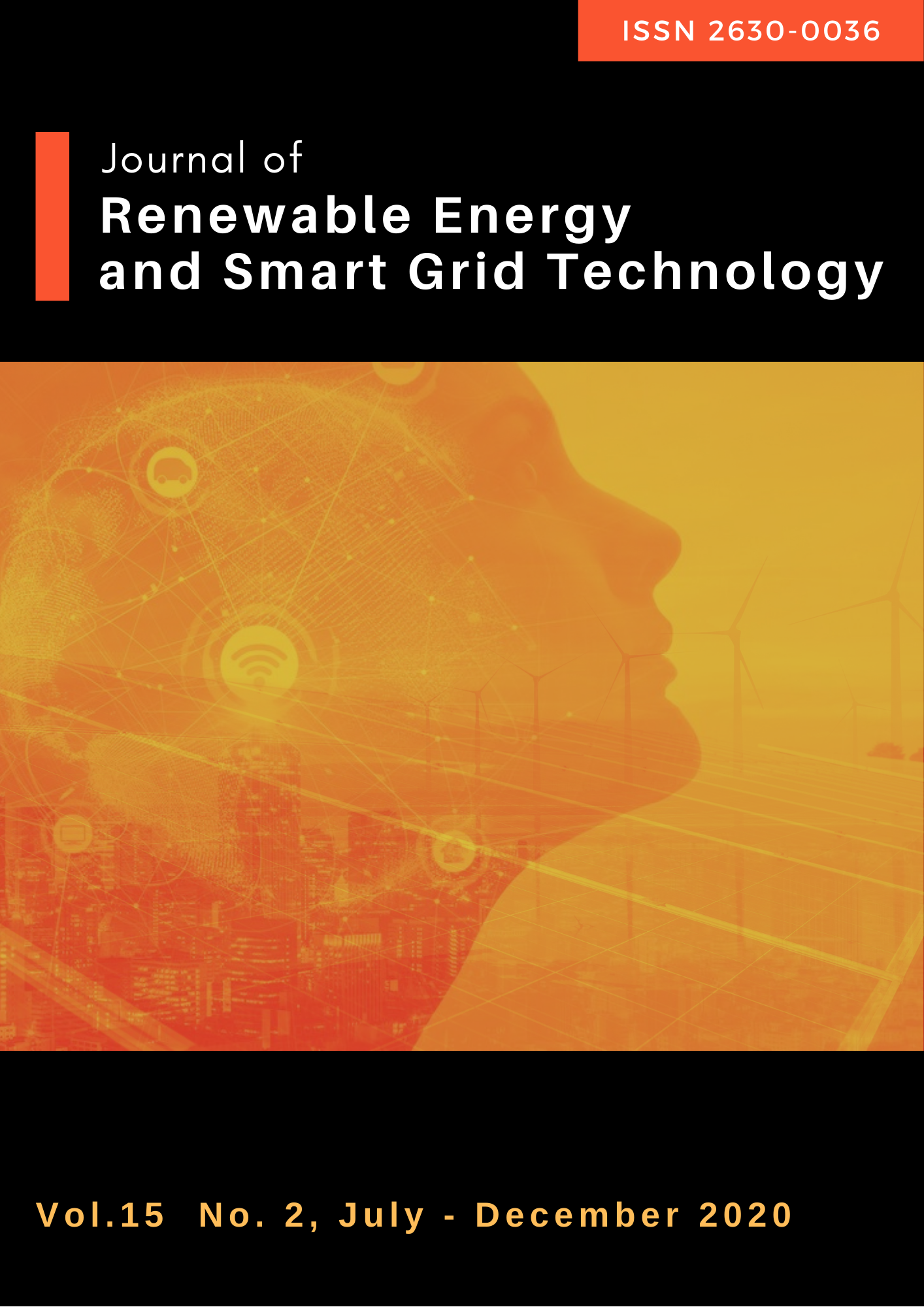Preparation of Activated Carbon from Cassava Root for Cadmium Removal in Aqueous Solution Sample
Keywords:
Activated Carbon, Cassava Root, Phosphoric Acid, Heavy MetalAbstract
The purpose of this research was to study the properties of activated carbon produced from cassava root using phosphoric acid as catalyst at various ratios between charcoal and phosphoric acid and activated at different temperature levels. The chemical properties such as moisture, ash, volatile matter content and the amount of fixed carbon were determined. The surface morphology was observed using scanning electron microscopy (SEM); and elemental analysis were done using energy-dispersive X-ray spectroscopy (EDX). The study analyzed the effectiveness of the activated carbon in removing cadmium in water. The cadmium adsorption was determined using an atomic adsorption spectrometer (AAS). The results indicated that activated carbon could remove from 99 -100 % of cadmium in an aqueous solution. The cassava roots are agricultural residues that can be used to produce activated carbon, which can adsorb heavy metals from industrial wastewaters. As such, it can add value to cassava roots, providing an effective and profitable way for disposal of agricultural waste.
References
Treto-Suárez, M.A., Prieto-García, J.O., Mollineda-Trujillo, A., Lamazares, E., Hidalgo-Rosa, Y., & Mena Ulecia, K. (2020). Kinetic study of removal heavy metal from aqueous solution using the synthetic aluminum silicate. Scientific Reports, 10(1),1-13.
Tang Liu, J. & Tang, M. (2017). Wastewater management approach in an industrial park. Water Science and Technology, 2, 546–551.
Campinas, M., Mesquita, E., Viegas, R., & Rosa, M. J. (2016). Using activated carbon based technologies for the removal of emerging contaminants from water/wastewater: UQTA (LNEC) Projects. Boletín del Grupo Español del Carbón, 40, 13-17.
Ioannidou, O. & Zabaniotou, A. (2007). Agricultural residues as precursors for activated carbon production - A review. Renewable and Sustainable Energy Reviews, 11(9), 1966-2005.
Tan, I. A. W., Ahmad, A. L., & Hameed, B. H. (2008). Preparation of activated carbon from coconut husk: Optimization study on removal of 2, 4, 6 trichlorophenol using response surface methodology. Journal of Hazardous Materials, 153(1-2), 709-717.
Prahas, D., Kartika, Y., Indraswati, N., & Ismadji, S. (2008). Activated carbon from jackfruit peel waste by H3PO4 chemical activation: Pore structure and surface chemistry characterization. Chemical Engineering Journal, 140(1-3), 32-42.
Ould-Idriss, A., Stitou, M., Cuerda-Correa, E. M., Fernández-González, C., Macías-García, A., Alexandre-Franco, M.F., & Gómez-Serrano, V. (2011). Preparation of activated carbons from olive-tree wood revisited. I. Chemical activation with H3PO4. Fuel Processing Technology, 92(2), 261-265.
Yagmur, E., Tunc, M.S., Banford, A., & Zeki, A. (2013). Preparation of activated carbon from autohydrolysed mixed southern hardwood. Journal of Analytical and Applied Pyrolysis, 104, 470-478.
Siwdol, K., Wongphak, P., & Panadda, T. (2017). Effects of carbonization temperature on properties of activated carbon prepared from cassava rhizome waste disposal from starch industry. International Journal of Management and Applied Science, 3(12), 1-3.
Yorgun, S. & Yıldız, D. (2015). Preparation and characterization of activated carbons from Paulownia wood by chemical activation with H3PO4. Journal of the Taiwan Institute of Chemical Engineers, 53, 122-131.
Tshala-Katumbay, D. D., Ngombe, N. N., Okitundu, D., David, L., Westaway, S. K., Boivin,
M. J., Mumba, N. D., & Banea, J. P. (2016). Cyanide and the human brain: perspectives from a model of food (cassava) poisoning. Annals of the New York Academy of Sciences, 1378(1), 50–57.
Graham, J., & Traylor, J. (2020). Cyanide Toxicity. Florida, Treasure Island (FL): StatPearls. Retrieved January 12, 2020, from https://www.ncbi.nlm.nih.gov/books/NBK507796/
Rhaman, M., Haque, M., Rouf, M., Siddique, M., & Islam, M. (2015). Preparation and characterization of activated carbon & amorphous silica from rice husk. Bangladesh Journal of Scientific and Industrial Research, 50(4), 263-270.
Maneewan, S., Vorasingha, A., Aryuteun, N., & Khamnuansin, N. (2008). Activated carbon from tamarind shell for air filter of color coating industry (research report). Phitsanulok, Naresuan University.
Rattanapan, S., & Kongsune, P. (2018). Methylene blue adsorption onto activated charcoal prepared from mangosteen peel. Thaksin Journal, 21(2), 51–59.
Sukananta, P. (2010). Investigation of surface property and characteristics of the activated carbon from mangosteen shell prepared by the single and two stage. Agricultural Science Journal, 41(3/1), 285–288.
Visarnbannavit, V. (2011). The optimal condition for activated carbon production from durian shell and mangosteen shell for using in molasses color removal (master’s thesis). Bangkok, Chulalongkorn University.
Jiwalak, N., Tangsathikulchit, C., & Tangsathikulchit, M. (2006). Activated carbon from Lignite coal by chemical activation with Potassium Hydroxide. Suranaree Journal of Science and Technology, 13(3), 207–218.
Chongrak, N. (2011). Production of activated carbon from longan seed by activation with zinc chloride and potassium hydroxide (master’s thesis). Bangkok, Chulalongkorn University.
Mopoung, S. (2017). Production of Pure-Activated Carbon from Lignite (research report). Phitsanulok, Naresuan University.
Toles, C., Rimmer, S., & Hower, J. C. (1996). Production of activated carbons from a Washington lignite using phosphoric acid activation. Carbon, 34(11), 1419–1426.
Mestre, A.S., Pires, R.A., Aroso, I., Fernandes, E.M., Pinto, M.L., Reis, R.L., Andrade, M.A., Pires, J., Silva, S.P., & Caryalho, A.P. (2014). Activated carbons prepared from industrial pre-treated cork: Sustainable adsorbents for pharmaceutical compounds removal. Chemical Engineering Journal, 253, 408–417.
Nakrai, J. (2006). Color removal from leachate using activated carbon from Tamarind Seeds (master’s thesis). Bangkok, Chulalongkorn University.
Chaipradapphet, P. (2006). Cadmium and zinc removal in synthetic wastewater by activated carbon prepared from coconut shell and tamarind seed (master’s thesis). Bangkok, Chulalongkorn University.
Chunsiriporn, J., Kaewpradit, P., & Pongyeela, P. (2016). Activated carbon production from rubber wood charcoal produced from biomass power plant for water filtration (research report). Songkla, Faculty of Engineering Chemical Engineering, Prince of Songkla University.
Downloads
Published
How to Cite
Issue
Section
License
All copyrights of the above manuscript, including rights to publish in any media, are transferred to the SGtech.
The authors retain the following rights;
1. All proprietary rights other than copyright.
2. Re-use of all or part of the above manuscript in their work.
3. Reproduction of the above manuscript for author’s personal use or for company/institution use provided that
(a) prior permission of SGtech is obtained,
(b) the source and SGtech copyright notice are indicated, and
(c) the copies are not offered for sale.









